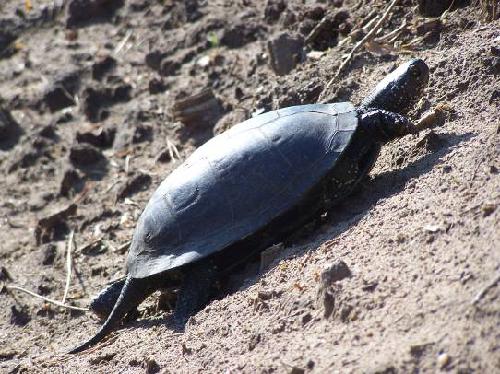Sergey Drobenkov
Other projects
29 Aug 2008
Numerous Nesting Aggregations in the European Pond Turtle in South Belarus: Distribution, Current Threats, and Primary Priorities for Steady Conservation (Belarus)
27 Sep 2010
Saving of Abundant Nesting Assemblies of the European Pond Turtle in Belarus: Creation of the Reserve Network and the National Conservation Plan Development
The main aim of this project is inventory of abundant nesting aggregations (mini arribada) and conservation of the largest population of the European pond turtle at the northern range limit in Belarus.

Female at seasonal migration to nesting site.
Arribada is large synchronous aggregation of sea turtle females in preferred sites in a nesting season. The arribada are known among sea turtles only. Arribada, but in smaller quantity, recently has been found at European pond turtle (Emys orbicularis) in Belarus in Pripyat River basin. On some open sandy hills from 5-15 to 50-70 (maximum - up to 300) females are coming. The area of local nesting sites equals 0.5-3 (up to 6) hectares, but clutch density quite often reaches 2-3/10 m2. The adult females come back to constant nesting sites annually. In preferred ground nesting places, the females are accumulated from environing territory of 10-15 km2. They make long-distance water and land migrations (up to 3-4 km), when moving to habitual breeding ground.
The reason of this phenomenon is not known. It is not known also about turtle orientation mechanism at the migrations. Pripyat river basin is explored in the course of human activities very intensively. The communal breeding sites of turtle are used as a sand source for construction of roads, dams, drain channels. Many females perish during ground movements when crossing the motor roads. Egg-eating predators (red fox, raccoon dog, and wolf) destroy up to 80% of clutches. The number of this population has sharply reduced lately. Unique mini arribada of freshwater turtle in Belarus without special measures will disappear in the near future.
The distribution map of communal breeding places of the turtle in Pripyat River basin will be made. Large number sites will be presented to Ministry of Nature and Resources of Belarus and local authorities for urgent creation of new national and regional wildlife refuges. Anti-predator system for communal nesting places will be developed (special equipment for clutch protection, selective hunting, and scaring away of egg-eating predators). The National conservation program as the form of package of recommendations including micro-reserves network, protection environment measures, predator control, amendments and changes of wildlife management laws will be prepared. The poster for ecological and environmental education of general public, local residents, fisherman, and tourist will be released.